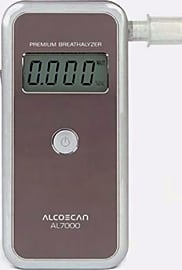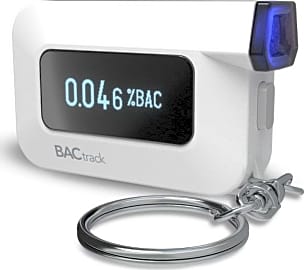The 8 Best Breathalyzers

This wiki has been updated 39 times since it was first published in April of 2015. Drunk driving kills thousands of Americans every year, so there's no substitute for staying sober if you know you're getting behind the wheel. One of these breathalyzers can act as a good deterrent to irresponsible and dangerous behavior, but it's important to note that these are only intended to provide a guide and should not be relied on if you think you may have had one too many to drive. When users buy our independently chosen editorial picks, we may earn commissions to help fund the Wiki.
Editor's Notes
March 29, 2021:
It was a particularly uneventful round of updates, and one that saw our list leaving almost exactly as it came. We did take notice of, and put some thought into including, some new budget picks for the category, but considering how high the stakes are, we wanted to be extra careful not to include any options without being absolutely convinced of their quality. With that in mind, and believing that the last editor for this page did a nice job of ranking some of the best selections on the market, we resolved to leave this list basically untouched, at least until our next round of updates.
It’s been said on this page already, but it can’t be said enough: these devices are no substitute for sober driving and responsible decisions, and are intended, at best, to provide guidance. By all means, have your fun this weekend, but do it safely, even if it means calling a cab or ride-sharing service to get you home.
February 06, 2020:
While staying sober when driving is always the smartest option, if you plan on having a drink or two before getting behind the wheel, it doesn't hurt to have one of these breathalyzers on hand to ensure your blood alcohol concentration is well below the legal driving limit. That being said, no machine should be a substitute for responsible decision making, and if you are worried you may be even slightly intoxicated, it is best to take an Uber or taxi home, even if one of these breathalyzers says you are good to drive. Not only is there the potential for an erroneous test result with a breathalyzer, but some people are too impaired to drive even if their blood alcohol content is low.
While we did our best to ensure that every model on this list will offer accurate results, two models seem to stand out above the rest as being the most reliable. The Bactrack S80 Professional is a pro-grade model that will not show a false positive for someone who is diabetic or on a low-calorie diet. And the Dräger Alcotest 3820 meets the standards for evidential testing, which means it should be as accurate as those used in a court of law. That being said, the AlcoMate AlcoScan AL7000 is approved for law enforcement and Coast Guard use, and it utilizes a user-replaceable sensor, so you'll never have to send it away for calibration. Unfortunately, it relies on oxide semiconductor technology, which is known to provide more false positives than fuel sensors.
When it comes to convenience and features, it is hard to beat the Bactrack Mobile BT-M5 and Bactrack C6, both of which connect to smartphone apps that offer some useful extras, like the ability to estimate when you will be sober and connect directly to Uber to help you hail a ride when you are too intoxicated to drive.
Special Honors
Intox EC/IR II An evidential-grade desktop model, the Intox EC/IR II is similar to what you might find in a police station. It utilizes an electrochemical fuel cell sensor that will not respond to acetone, as well as an infrared detection system that can determine if a deep lung sample has been collected. intox.com
The Pre-breathalyzer Days
Before cars became commonplace, an overly intoxicated person was just a minor nuisance for the rest of society.
Before cars became commonplace, an overly intoxicated person was just a minor nuisance for the rest of society. People walking or riding a bicycle or horse home after a long night of drinking posed little danger to others. Driving a car while drunk was an entirely different matter. Even with few cars on the road, drunk driving was already a problem, and by 1910, New York instituted the nation's first drunk driving laws.
After the end of World War I, cars became more affordable for the common man. They were no longer just playthings for the rich, which meant an increased number of cars on the road, and, in turn, even more drunk drivers. Despite the passing of the Prohibition Act in 1920, drivers were still commonly getting behind the wheel while drunk, which was leading to an increasing number of causalities.
At the time, the only way for a policeman to determine whether a driver was too drunk to drive was by observing the driver for known signs of intoxication, including bloodshot eyes, slurred speech, and the smell of alcohol on the breath. They also used a series of agility and balance tests, which have since become known as field sobriety tests. This also meant that being too drunk too drive was subjective, as there was no way to truly determine exactly how much a person had drunk. What one policeman may have considered intoxicated, another policeman might not.
When prohibition was repealed in 1933, the drunk driving problem only worsened. In the first six months of 1934, drunk driving deaths in Chicago quadrupled compared to the previous year, before prohibition was repealed. This lead to an increased urgency among public health officials and the government to find a solution to the problem.
Early Breathalyzers
Work first began on creating a device capable of determining how intoxicated a person was in the 1920s. It was already known at the time that blood could provide a reliable measure of blood alcohol content (BAC), but as drawing blood is quite invasive, it wasn't a practical option for policeman during field stops. In 1927, Dr. Emil Bogen conducted a study to see what other options there were to determine BAC. He learned that breath was just as reliable as blood.
Work first began on creating a device capable of determining how intoxicated a person was in the 1920s.
He went on to create a device comprised of a large football bladder filled with a combination of potassium dichromate and sulpheric acid. When intoxicated people breathed into the bladder, the chemicals inside would change from yellow to shades of blue or green based on the amount of alcohol on their breath. The color of the chemicals were then compared to tubes, which contained the same chemicals and a known amount of alcohol. This device was effective, but still impractical for roadside use.
In 1931, another scientist by the name of Dr. Rolla N. Harger announced his work on a different method for using breath to determine BAC, and by 1938 he had a functioning device. When asked the name of his device, Harger half jokingly said "the Drunkometer," but joke or not, the name stuck. There were a few other devices created at the same time that could also be used to determine BAC by breath: the Intoximeter, and the Alcometer.
The Indiana State Police conducted the first real world test of Harger's device around the same time that the Intoximeter was being implemented by the Los Angeles Police. Harger's device proved to be more successful, and by 1940 a number of other police departments in different parts of country were using it.
The Modern Day Breathalyzer
Robert F. Borkenstein invented the first modern day breathalyzer in 1954. It was the first truly portable breathalyzer that could be included in every police officers toolkit. It didn't have any of the large bladders or complex chemical solutions of the previous devices. Borkenstein's breathalyzer was comprised of two filters, two photo cells, a device to collect the breath, and six wires. It utilized chemical oxidation and photometry to determine alcohol concentration. Newer breathalyzer models have converted to using infrared spectroscopy, but they still function in much the same way.
Borkenstein's breathalyzer was comprised of two filters, two photo cells, a device to collect the breath, and six wires.
Even with a reliable way to determine a driver's BAC, Americans still adopted a lenient attitude towards drunk driving. When other countries in the world, like those in Scandinavia, had legal driving BACs of 0.05 or 0.08 percent in the 1940s, America still considered anything under 0.15 percent as not intoxicated and not worthy of prosecution. Currently all 50 states have the legal driving limit set at 0.08 percent.
It wasn't until the 1960s that America's national attitude towards drunk driving began to change. In 1964, Borkenstein conducted the Grand Rapids Study, which estabilished a definitive link between car accidents and high blood alcohol content. Four years later, in 1968, the U.S. Department of Transportation conducted their own study and found that 50 percent of fatal car accidents in the United States involved alcohol.
The most modern breathalyzers are electronic and use fuel sensors to accurately determine BAC within a few seconds. Most feature a backlit digital display and are small enough to fit in the pocket for easy carrying, allowing one to double check their BAC before stepping behind the wheel.













